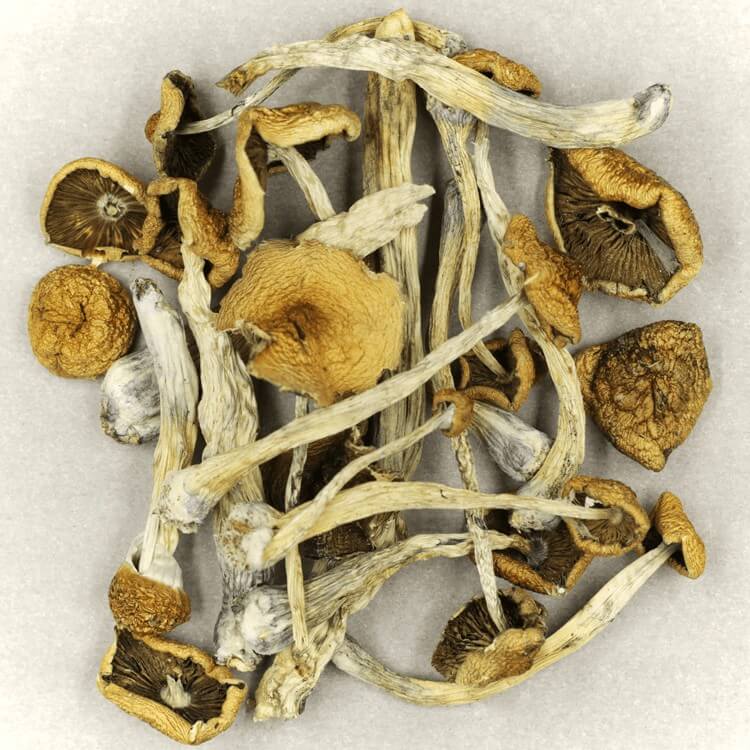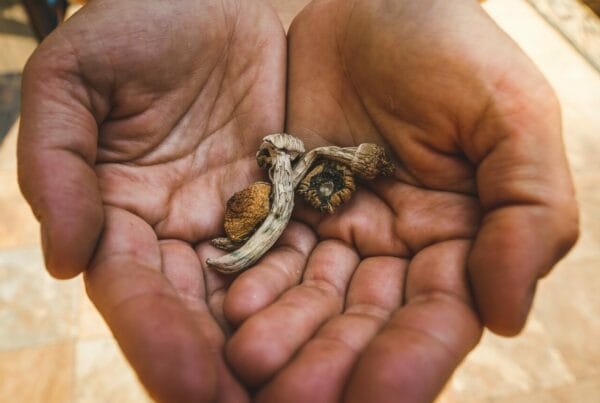The strength of Psilocybe mexicana was once thought to be a myth but recent research in psilocybin has drastically changed this viewpoint. The scientific community focusing on psychedelics is consistently unveiling its healing potential, gradually paving the way for its acceptance within the medical sphere. This burgeoning field is viewed as promising by experts who are diligently working to determine safe dosage levels for medical applications.
Key Takeaways
- Researchers are utilizing innovative techniques like liquid chromatography coupled with tandem mass spectrometry to measure the potency of mushrooms.
- Psilocybe Mexicana, among various other mushroom species, is being studied in clinical trials to gauge its potential medicinal benefits.
- The genetic variation in magic mushrooms plays a crucial role in devising an accurate dosage guide.
Psychedelic Mushrooms: Journey from Mystery to Scientific Revelations
Previously, only a limited number of conditions were believed to benefit from Psilocybe Cubensis. However, currently, psilocybin is making impressive progress in revealing its concealed medicinal attributes.
Scientists are exploring the potential of Psilocybe Mexicana and other potent strains through clinical trials and in-depth research. Regardless of whether the subjects are in vivo or in vitro, this strain proves effective in delivering the most genuine effects and benefits of the fungus species.
Psychedelics Gaining Market Presence
From obscurity to revelation—the continuous progress and discoveries are progressively sparking public curiosity, particularly among those seeking therapeutic remedies. Conventional treatments for mental health disorders often lack efficacy, prompting individuals to explore more effective alternatives.
Enter magic mushrooms.
Patients suffering from mental health disorders are resorting to psilocybin, which has demonstrated potential in treating depression, alcohol dependence, anxiety, compulsions, tics, chronic pain, and more.
Currently, medical practitioners are probing innovative ways to accurately determine the most effective dosage for safe patient administration. Notably, a group of researchers from the University of Texas has devised a model to extract psilocybin and psilocin concentrations.
It is feasible to clinically ascertain the potency of magic mushrooms.
The Distinctive Features of Mexicana
The Golden Teachers, Blue Meanies, and B-Plus magic mushroom species have been thoroughly examined in research. However, for a more comprehensive understanding of safe magic mushroom usage, it is necessary for researchers to investigate other species.
The Mexicana species has gained popularity in research circles, not just due to its status as one of the oldest species, but also because its relatively low potency increases the possibility of it meeting medical drug standards.
Despite the less intense potency of this Mexican strain compared to other species, it can still produce the same effects as the more common strains. As the practice of microdosing gains traction among patients, this strain emerges as a top contender.
It possesses consistent levels of psilocybin and psilocin, like other strains. So, what makes it stand out from similar strains? Its historical and anthropological significance provides the answer.
Delving Into A Fascinating “Mexican” History
In ancient times, the psilocybe mexicana naturally thrived in moss. These psilocybin mushrooms were deeply respected by indigenous people for their diverse applications, often related to mystical or supernatural occurrences.
Let’s focus on Mexican mushrooms. More than 2000 years ago, North and Central American natives first used these mushrooms. These sacred mushrooms, referred to by the ancient Aztecs as the “food of the Gods,” or “teonanácatl” in their native language, have been integral to their culture.
If the Aztecs were present today, they would attest to the transformative, emotionally profound, and mentally balancing effects of the Mexicana—despite these terms being unfamiliar to them.
Despite variations in cultivation methods, this mushroom has successfully preserved its natural psilocybin concentrations, a testament to its authenticity. This authenticity is a recognized standard that both researchers and psychedelic research institutions greatly appreciate.
Innovative Means of Testing Psilocybin Content and Potency
A team of ten researchers from the University of Texas at Arlington and other institutions have developed a novel method for testing the potency of psychoactive compounds in mushrooms. This innovative technique combines liquid chromatography and tandem mass spectrometry.
Here are two groundbreaking methods:
- Liquid chromatography is a technique used to isolate and study the components of chemical mixtures. It particularly aids in the analysis of active chemicals found in shrooms by allowing a liquid sample to flow through a column packed with a solid substance, known as the stationary phase. The variety of interactions between the chemicals in the sample and the stationary and mobile phases leads to their separation at different rates as they traverse the column.
- Spectrometry is a field primarily focused on exploring the interactions between matter and electromagnetic radiation at different wavelengths. It facilitates the identification and quantification of substances through the specific wavelengths of light absorbed and scattered by molecules, thus enabling the determination of the electronic, vibrational, and rotational states of the chemicals.
This approach was utilized in the study of five different strains of magic mushrooms. The investigators found that the average combined levels of psilocybin and psilocin across these strains ranged between 0.879 and 1.36, exceeding those found in various other strains, including Bull Run and Cambodian. They confirmed the precision of their study by juxtaposing their findings with those of other independent laboratories.
The alignment of results from the two laboratories further bolstered the reliability of their testing method in accurately determining the potency of the mushrooms.
If this is confirmed by specialists, it could pave the way for a new set of techniques to complement existing methods of measuring psychedelic strength, adding another layer of safety to prevent incorrect dosage calculations.
Expanding Research to Include Other Species
Extending research to encompass other species can be advantageous, as it could deepen our knowledge of the health benefits derived from different strains and supply critical data regarding the effects of less potent mushrooms.
Furthermore, it can contribute to public education about the influence of dosage variations on the psychedelic experience. By contrasting the Mexicans strain with more potent strains such as Psilocybe Cubensis, researchers can ascertain how different concentrations of active compounds may impact therapeutic results.
For example, the Blue Meanies strain yields more powerful hallucinogenic effects, which might prove effective in treating conditions like depression. On the other hand, strains with lower potency may be more suitable for microdosing or for more subtle uses such as mood enhancement or focus improvement.
Genetic Diversity Can Lead to Safer Treatments
It’s worth noting that different cultivars or varieties exhibit distinctive genetic profiles and have different strengths, chemical compositions, and effects. Acknowledging this diversity allows healthcare professionals to select the most suitable type for specific medical purposes and adjust doses to meet individual requirements, thereby reducing risks and enhancing benefits.
Take, for instance, Psilocybe Semilanceata (Liberty Caps) or Psilocybe cyanescens. These possess unique alkaloid profiles that might be effective in managing anxiety. On the other hand, other synthetically grown mushrooms may be more fitting for addressing substance dependence or compulsions. This diversity aids in the development of personalized treatment plans with increased safety and efficacy.
From this, we can infer that the genetic diversity in hallucinogenic mushrooms, coupled with novel methods of evaluating strength and identification, is vital for the creation of safer medical treatments.
Enhanced Safety for Medical Use
Let us consider the potential of safer dosing.
- Decreased risk of overdosing: With accurate dosing, users no longer need to fear overdosing. This suggests that product labels need to be more straightforward to avoid consumer misunderstanding.
- Increased predictability: Individuals can foresee the effects or experiences they may encounter during their trips with more precise dosing. This can reduce overwhelming sensations and anxiety, thereby leading to patient contentment.
- Uniform measurements: One way or another, accurate dosing can encourage a uniform metric that allows people to easily refer to charts for potential effects.
Enjoy the Advantages of Accurately-dosed Mushrooms via Advanced Potency Tests | Buy Magic Mushrooms Online at Shroomland Canada
If these two groundbreaking techniques continue to be used, you won’t have to deal with unpredictable effects anymore. Combine this with smart online shopping at Shroomland Canada. We offer dried mushrooms that provide a serene, calming psychedelic journey without excessive psychoactivity. Order psychedelics online in Canada through Shroomland Canada.
Frequently Asked Questions
Are Psilocybe Mexicana and Big Mexicans the same?
No, Big Mexicans and Psilocybe Cubensis are distinct strains of mushrooms, so it’s crucial to not confuse them. Big Mexicans have a higher compound isolation, ranging from 0.5% to 1%, making them significantly more potent.
Psilocybe Cubensis and Psilocybe Mexicana have different appearances, with the former often having a bell-shaped cap and the latter typically having a conical shape.
What’s the highest concentration in Mexican mushrooms?
Mexican mushrooms can contain up to 0.25% concentrations of both psilocybin and psilocin. While this concentration is relatively low, comparable to the Golden Teacher strain, it can still provoke powerful psychedelic experiences, which may have potential health benefits.
What’s the recommended safe dosage for medicinal use?
The typical recommended dosage ranges from 1 to 2 grams. However, the dosage can fluctuate depending on factors such as the method of consumption, individual metabolism, and the specific potency of the strain. Some people opt for lower doses, from 0.05 grams (50mg) to 0.25 grams (250mg), to moderate the psychedelic effects.





